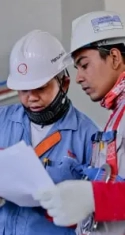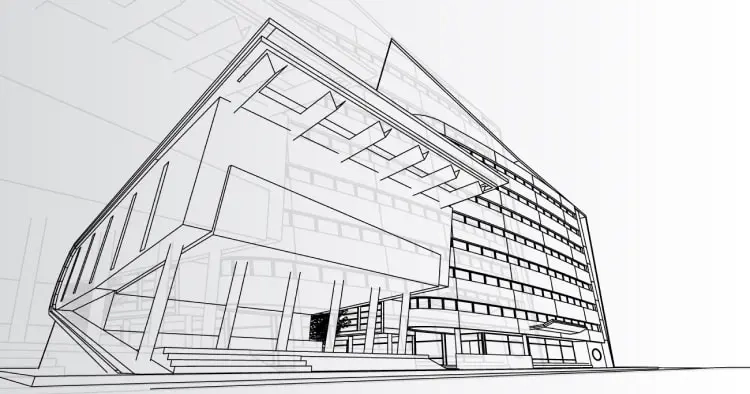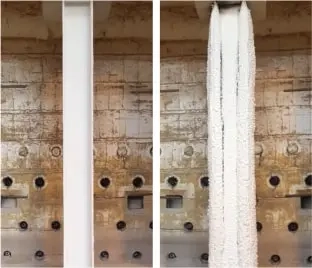How to Achieve a Higher Fire Rating on Gypsum, Metal and Wood

A building can only operate if it meets specific standards for fire safety. These standards are not static and keeping a building’s structure updated to fire ratings codes and standards requires both a good understanding of them as well as effective strategies to implement changes at reasonable costs. When upgrading to a 1 or 2 hours fire rating, one option to consider is to add intumescent coatings to the desired structure.
This whitepaper provides a technical and regulatory review of intumescent coatings with an emphasis on intumescent paint. As shown, intumescent paint can be a cost-effective solution to fire resistance upgrading that is recognized by the International Building Code (IBC) vs other standards as a valid product for protection against heat and fire.
- During building construction or renovation, a significant challenge that can arise is ensuring that the building is based on a design that meets the required standards for fire safety. Having a structure recognized as fire resistant requires, among other things, a good understanding of the building’s fire protection system and the tests certificates? that the building must have in order to function. The following example is a common phenomenon that many building officials face: floor-ceiling fire separation of the building is only 1 hour, but the IBC now requires it to be 2 hour-fire rated. More so, the commercial building is now required to have residential units on the 2nd floor.
- Those looking to upgrade 1 hour- to 2 hour-fire rating have several options to consider. One solution is to add more drywall, which increases the thickness of the separation. However, many may perceive this approach as time-consuming and not particularly cost-effective; it is also messy and problematic for installed lighting, ductwork, conduit, etc. Another option is foundation-to-roof masonry to separate the units. And yet another option is to spray a layer of intumescent paint, which gives 45 to 75 minutes more. Upgrades ½” gyp from 15-20 mins to 1 hour. Upgrades 5/8” Type X gyp from 45 mins to 2 hours, depending upon the thickness.
- Businesses may find fire resistant paint as a method that as easier, cheaper, and one that provides a better aesthetic look. However, as a new method, many parties involved either don’t understanding intumescent products or don’t totally trust them as reliable fire-resistant products. A careful review of relevant building codes and fire resistance rating standards may provide the needed insight before upgrading a building’s fire rating.

Fire resistance ratings are used by UL, ASTM, and building codes such as IBC to determine the capacity of construction elements to contain fire within a zone comprised of floor, ceiling, and fire-resistance rated walls.
Ratings for fire resistance are given in accordance to the time a structure can contain a simulation fire. More specifically, if a wall is constructed in a manner that closely resembles a tested wall which has shown to contain flames and high temperature for one hour, it is eligible to receive a 1-hour rating. Similarly, a wall resembling a tested wall that has shown to contain flames and heat for two hours can receive a 2-hour rating.
Drywall is a very popular construction material in the United States, which makes it almost impossible to discuss fire-resistance rating without mentioning the material. Drywall is made of calcium sulfate dihydrate (gypsum) and may or may not contain additives. Gypsum drywall can be regarded as an effective barrier against fire, as the product is combined with water, which is released as steam if the drywall is exposed to fire. Fire rated gypsum drywall shows fire resistance to a higher degree due to its glass fiber reinforcement.
Fire rated drywall has to be certified by a third party. The certification is usually obtained by independent testing which establishes whether a company meets the fire performance required by regulation. The most common fire rated drywall is known as type X, which is 5/8 inches thick, placed on each side of 2 by 4 or 2 by 6 inch wood studs and has a minimum fire rating of 1 hour.
When a building contains several occupancies, it is necessary to assess whether they can be considered non-separated or separated occupancies. Exceptions only apply when occupancies can be considered as accessories in accordance with IBC Section 508.2.
IBC has specific provisions for mixed occupancies. Non-separated occupancies, as defined in Section 508.3, require no separation between different occupancies in terms of rated assemblies such as walls, except for hazardous occupancies, with a few exceptions such as the separation between dwelling and sleeping units. Separated occupancies, as defined in Section 508.4 require different occupancies to be separate using rated walls and floors/ceilings. Section 508.4 contains a table which shows the required hourly ratings for assemblies that separate occupancies. The required hourly rating can sometimes be reduced if the building includes an NFPA 13-compliant automatic sprinkler system.

While fire-resistive cementitious coatings are an option to consider when seeking to increase fire ratings of gypsum boards, they are not typically regarded as aesthetical. Intumescent paint, on the other hand, cannot be visually distinguished from regular paint and provides the needed fire-resistive function.
Intumescent paint responds to fire by swelling to several times the original thickness. The gained insulating char protects the elements composing the substrate from fire. When exposed to heat, an intumescent product expands or swells, which makes it act as a barrier and protect the substrate. Regular 5/8" gyp board only gives 30 minutes of rating while gypsum type X can give 1 hour.
Intumescent paint can upgrade the structure to 2-hour rating. Products based on intumescent paint can typically be applied to steel, sheet material, sheetrock, composite panels, and interior woods. Intumescent products can be used on several wood surfaces, including doors, claddings, paneling, soft and hardwoods, gypsum, and other combustible substrates.
Regulations for the built environment meant to protect against fire and restrict its spread take the form of codes, standards, and laws. A code is a law or regulation that establishes the minimum requirements where something must be done while a standard typically specifies the methods for achieving the objective. The private-sector standards development system that exists in the United States is mostly self-administered and oversight and coordination are provided by the American National Standards Institute (ANSI)- a federation of codes and standards developers, company organizations and government users of the standards. ANSI represents the interests of several organizations, including private-standards-development organizations such as the ASTM.
IBC is developed by the International Code Council (ICC) and serves as the base code standards by most jurisdictions in the United States. The code addresses both safety and health concerns for buildings based upon performance and prescriptive requirements and is compatible with all other published ICC codes.

According to code 722.5.2 Prayed fire-resistant materials of the International Building Code (IBC), “the fire of structural steel beams and girders protected with intumescent or mastic fire-resistant coatings shall be determined on the basis of fire-resistance tests in accordance with Section 703.2.” By mentioning intumescent coatings protection, the code recognizes the validity of the material for protection against heat and fire.
It is worth noticing that intumescent paint cannot be regarded as fireproof paint. Fire resistance rating is establishing according to a product’s ability to limit temperature rise on the unexposed side when tested with fire resistance test standards such as CAN/ULC S101. Flame-spread measures the spread and flammability of flames along a sample as well as the amount of smoke products when a product is exposed to an ignition source. Common used flame-spread classifications include Class I or A, with a 0-25 FSR c; Class II or B with a 26-75 FSR; and Class III or C with a 76-200 FSR.
The mentioned Section 703.2 specifies the methods used for determining fire resistance. The application of any of the methods included in the section must be based on the fire exposure and acceptance criteria specified in ASTM E119 or UL 253. The required fire resistance of a building element includes the following method: 1. Fire-resistance designs documented in approved sources; 2) Prescriptive designs of fire-resistance-rated building elements prescribed in Section 721 of the same code; 3) Calculations in accordance with Section 722; 4) Engineering analysis based on a comparison of building element as determined by test procedures established in ASTM E119 or UL 263 (these test standards are meant to evaluate the duration for which the types of specific building elements contain a fire, retain their structural integrity, or exhibit both properties during a specified test exposure; for a summary of these tests, see ); 5) Alternative protection methods as specified in Section 104.11; and 6) Fire-resistance designs certified by an approved agency.
The fire-resistance rating of building elements is established in accordance to test procedures specified in the ASTM E119 standards or UL 263 standards or in accordance with Section 703.3. The fire-resistance rating of penetration and fire-resistant joint systems are determined in accordance with Sections 714 and 715.
The provisions only apply to structural steel beams and girders protected with sprayed fire-resistant materials. Larger or smaller beam or girder shapes can be substituted for beams specific in approved unrestrained or restrained fire-resistance-rated assemblies as long as the thickness of the fire-resistant materials is adjusted according to the mathematical formula (Figure 1).
Special inspections and test for intumescent fire-resistant coating applied to structural elements and decks must be performed in accordance with AWCI 12-B. Special inspections and test are based on the fire-resistance framework as designed in the approved construction documents.
Figure 1. Larger or smaller beam or girder shapes can be substituted for beams specific in approved unrestrained or restrained fire-resistance-rated assemblies as long as the thickness of the fire-resistant materials is adjusted according to this mathematical formula, where:
- h = Thickness of sprayed fire-resistant material in inches.
- W = Weight of the structural steel beam or girder in pounds per linear foot.
- D = Heated perimeter of the structural steel beam in inches.
- Subscript 1 refers to the beam and fire-resistant material thickness in the approved assembly.
- Subscript 2 refers to the substitute beam or girder and the required thickness of fire-resistant material.
- Floor/Ceiling assemblies that are fire resistance rated in hours are required between sections in the case of multifamily, industrial and commercial buildings.
- Intumescent Coatings: A Closer Look
Intumescent products are composed of several chemicals suspended in a binder. The binder responds to heat by softening, which sends the suspended chemicals to the heat. The foam produced when intumescent coatings are exposed to heat is the result of chemical reactions, more specifically the vapors released by the reacting chemicals. As carbonization occurs, the foam solidifies into the insulating material known as a char.
- Intumescent coatings technologies tend to include vinyl toluene acrylics, fluoropolymer, silicone acrylics, chlorinated rubber, epoxies, urethanes, and styrene acrylics. An intumescent product can be solvent or waterborne, with the later being normally based on acrylic or vinyl acetate. Intumescent coatings used against hydrocarbon fires are epoxies. Typically, a thin film is used in general construction areas for structural steel and other elements while thick-film coatings are more likely to be used in the oil and gas industry. Low-VOC thick-film chemistries can be used to achieve specific goals, such as the ability to adhere to urethane foam. Growth opportunities for intumescent coatings may include combustion prevention, low smoke generation, and a polymer for formulating thinner films with the goal of increasing the aesthetics of steel surfaces.
- Intumescent paints are more often applied on exposed structural steel elements, as they can provide an improved finish from an aesthetical perspective while also providing the desired fire resistance. Intumescent paint sprays applied for structural fire protection results in a thick surface where a finished surround can be applied to protect the steel element.
- Intumescent paint must be applied to the steel in layers in order to generate the level of thickness required by the building code. The final layer of paint can be mixed with pigments in order to achieve the desired color. Products based on intumescent paints can also be used on structural members composed of wood. When used in this setting, intumescent paint can be useful to contain the spread of flame and smoke.
The demand for intumescent coatings tends to increase when construction spending increases. For instance, the United States is currently experiencing an increase in nonresidential construction spending, with an average growth for the last five years of 8.1%. Intumescent products are especially demanded by new industrial and commercial constructions, marine, transportation, and onshore/offshore oil and gas. Key drivers of the industry include the increased use of lightweight materials for transportations, insulation applications, and modular homes.
An increasing number of businesses are using intumescent paint to protect spherical structures that contain chemicals such as natural gas and peroxides. Intumescent coatings appear to be particularly relevant in commercial buildings, where flame-retardant chemicals can be used to achieve two different efficacy rating: 1) the flame spread/inflammability in accordance to ASTM E84; and 2) coating efficacy for delaying and resisting the effects of fire in a number of hours. Considering the key properties that fireproofing provides to steel structure, it is crucial to apply intumescent coatings properly in order to ensure public safety. In the case of some exterior applications, eliminating the need for topcoats over the intumescent products may be desired.
All buildings must meet specific standards for fire-safety in order to function. Keeping a building’s structure updated to fire ratings codes and standards is a must in order to implement changes that meet new requirements at reasonable costs. Intumescent coating products such as intumescent paint are an option to be considered for enhancing a structure’s fire rating, as the products are recognized by IBC as valid for protection against heat and fire and can often provide a cheaper and more aesthetical solution compared to drywall and foundation-to-roof masonry. At the present time, intumescent coatings are used in commercial buildings but also in marine, transportation, and onshore/offshore oil and gas. The market may increase as more people become familiarized with the products and their properties.